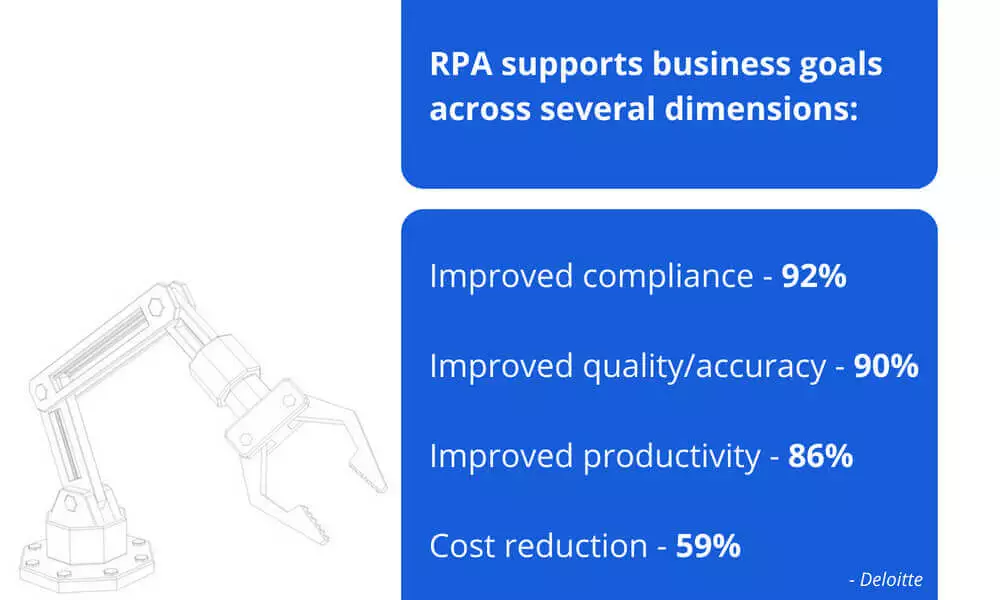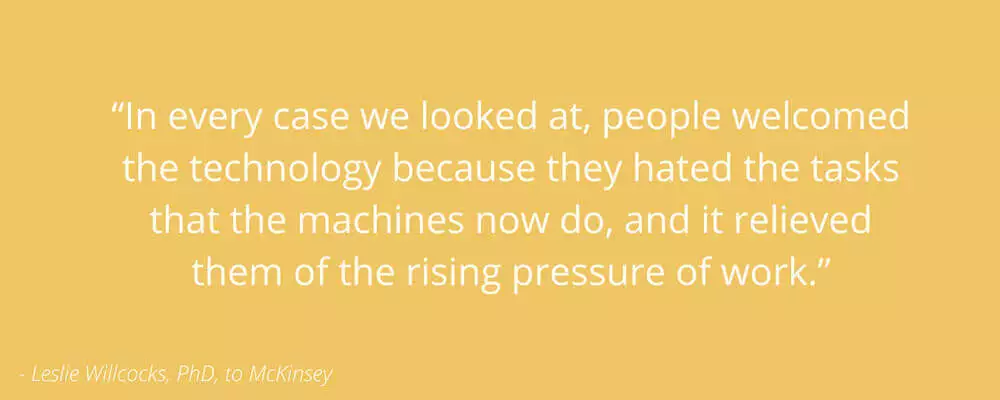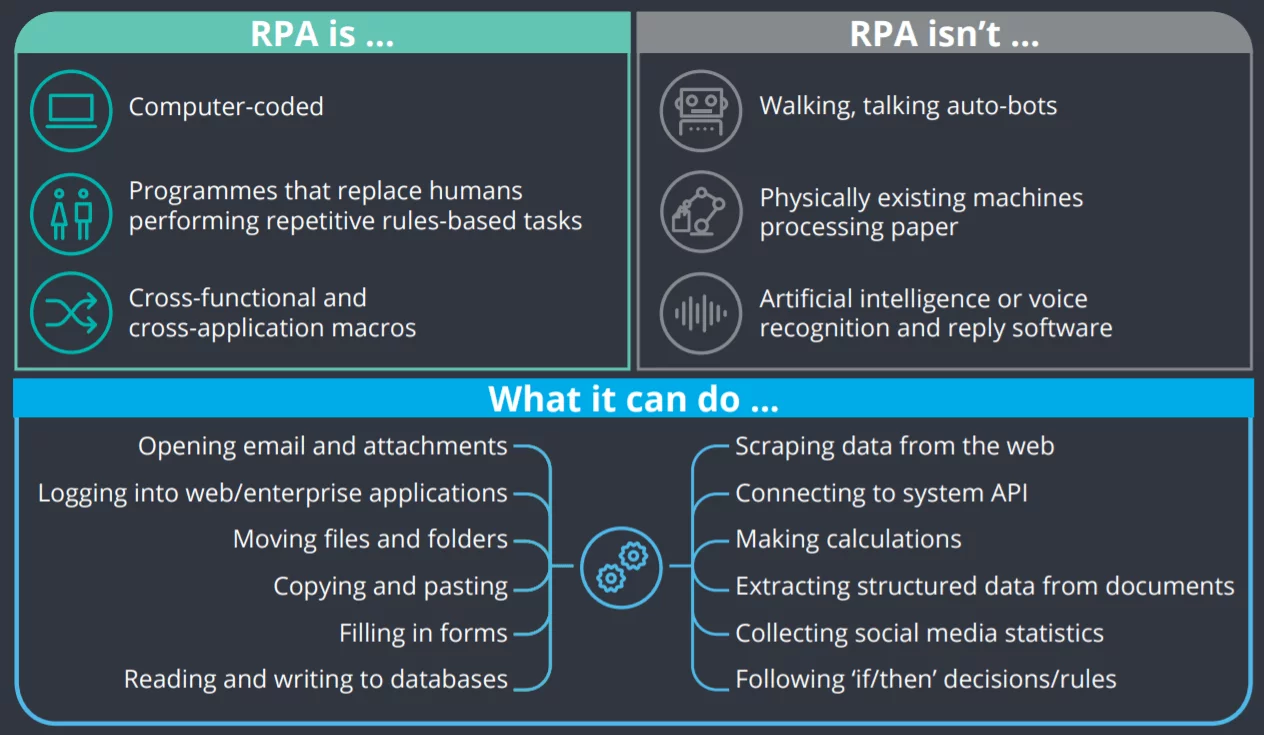What is it about automation that automatically incites dread in employees?
Robotic process automation has the potential to raise employee productivity to new heights. But while many leaders are eager to deploy this emerging technology, employees tend to express a different reaction: fear.
Workers often worry capabilities like automation and intelligent computing will eliminate the need for their jobs. In reality, tools like robotic process automation won’t replace human workers. They’ll simply take the robotic work out of human jobs.
 After some time, training, and experience using computers, employees realized these tools wouldn’t replace them. Instead, computers would enable them to work smarter — to do more with less effort and greater accuracy.
In the decades since the first computers entered offices, this weariness has repeated itself. With every new breed of technology that emerges, questions regarding the effects on human workers resurface.
Today, tools powered by artificial intelligence and machine learning have triggered these concerns once again.
Robotic process automation is particularly scary. For starters, it has “robotics” and “automation” — two words perceived as the greatest threats to human jobs.
But employees don’t need to fear robotic process automation. They should be excited about the potential of this technology to make their work more efficient, more interesting, and more productive than ever before.
After some time, training, and experience using computers, employees realized these tools wouldn’t replace them. Instead, computers would enable them to work smarter — to do more with less effort and greater accuracy.
In the decades since the first computers entered offices, this weariness has repeated itself. With every new breed of technology that emerges, questions regarding the effects on human workers resurface.
Today, tools powered by artificial intelligence and machine learning have triggered these concerns once again.
Robotic process automation is particularly scary. For starters, it has “robotics” and “automation” — two words perceived as the greatest threats to human jobs.
But employees don’t need to fear robotic process automation. They should be excited about the potential of this technology to make their work more efficient, more interesting, and more productive than ever before.
(Graphic from Deloitte)
 RPA can also be a great customer service tool. Automating processes that used to be done manually allows your employees to spend their time and energy focusing on the human aspects of the customer experience. It can also streamline certain tasks for customer service personnel, such as sorting and answering queries.
According to Deloitte, the majority (78%) of those who have already implemented RPA expect to significantly increase their investment in the technology over the next three years.
RPA can also be a great customer service tool. Automating processes that used to be done manually allows your employees to spend their time and energy focusing on the human aspects of the customer experience. It can also streamline certain tasks for customer service personnel, such as sorting and answering queries.
According to Deloitte, the majority (78%) of those who have already implemented RPA expect to significantly increase their investment in the technology over the next three years.
 As the amount of data, regulations, and bureaucracy companies deal with rises, employee workloads will continue to increase. The more help they can get streamlining tasks, the more productive they will be.
As the amount of data, regulations, and bureaucracy companies deal with rises, employee workloads will continue to increase. The more help they can get streamlining tasks, the more productive they will be.

 Outside of the C-suite, project managers and department heads must serve as change leaders who can communicate their vision for the technology to the rest of the organization. A solid change management framework is also critical for preventing employee resistance and gaining buy-in.
Outside of the C-suite, project managers and department heads must serve as change leaders who can communicate their vision for the technology to the rest of the organization. A solid change management framework is also critical for preventing employee resistance and gaining buy-in.
Raise employee productivity to the next level. Discover How.
Thriving in the digital era requires companies to increase efficiency and productivity. Leaders must make a compelling case for the technology that enables it. We’re here to help you do just that.Making the case for robotic process automation: A brief history of workplace tech
What happened when companies first started purchasing computers? Employees panicked. What were these devices? Executives promised their advanced computing and data processing abilities would raise business performance to new heights. But how would this strange new technology affect employees? Would it eliminate their jobs? After some time, training, and experience using computers, employees realized these tools wouldn’t replace them. Instead, computers would enable them to work smarter — to do more with less effort and greater accuracy.
In the decades since the first computers entered offices, this weariness has repeated itself. With every new breed of technology that emerges, questions regarding the effects on human workers resurface.
Today, tools powered by artificial intelligence and machine learning have triggered these concerns once again.
Robotic process automation is particularly scary. For starters, it has “robotics” and “automation” — two words perceived as the greatest threats to human jobs.
But employees don’t need to fear robotic process automation. They should be excited about the potential of this technology to make their work more efficient, more interesting, and more productive than ever before.
After some time, training, and experience using computers, employees realized these tools wouldn’t replace them. Instead, computers would enable them to work smarter — to do more with less effort and greater accuracy.
In the decades since the first computers entered offices, this weariness has repeated itself. With every new breed of technology that emerges, questions regarding the effects on human workers resurface.
Today, tools powered by artificial intelligence and machine learning have triggered these concerns once again.
Robotic process automation is particularly scary. For starters, it has “robotics” and “automation” — two words perceived as the greatest threats to human jobs.
But employees don’t need to fear robotic process automation. They should be excited about the potential of this technology to make their work more efficient, more interesting, and more productive than ever before.
Robotic process automation 101
Robotic process automation helps companies improve operational efficiency and lower overhead costs by taking over routine tasks and letting employees focus on higher-value processes. RPA uses rules-based algorithms to automate certain activities on enterprise software, web-based apps, and mainframe systems. In an interview with McKinsey, Leslie Willcocks, PhD, a professor of technology, work, and globalization at the London School of Economics, summed it up perfectly:“RPA is a type of software that mimics the activity of a human being in carrying out a task within a process. It can do repetitive stuff more quickly, accurately, and tirelessly than humans, freeing them to do other tasks requiring human strengths such as emotional intelligence, reasoning, judgment, and interaction with the customer.”
Who’s using robotic process automation?
RPA first gained a foothold in financial services firms, where leaders sought ways to streamline tedious processes without increasing the workforce or costs. But RPA can be applied to a variety of processes across different industries.The evolution #Digital and the #DigitalTransformation of the enterprise >> @MikeQuindazzi >> #AI #ArtificialIntelligence #RPA #Bots #Automation #Robotics #ERP #IoT pic.twitter.com/aA7SrtxV1Q
— Vaibhav Srivastava (@ivaibhavsri) July 24, 2018
Putting RPA to work
For example, where an employee might collect data, synthesize it, and organize it in an Excel spreadsheet, RPA can automate many of the steps in this process. It can also be used to generate automatic responses to emails, or instruct a software program to act when certain criteria are fulfilled.Many companies have already begun to realize the value of RPA. Out of 400 responses to a Deloitte survey, 53% of individuals said their company has already embarked on a RPA journey, while 19% said they plan to implement it in the next two years. At this rate, RPA will reach nearly universal adoption in the next five years. After recognizing the effectiveness of RPA, companies are beginning to expand its use. Sixty-four percent of respondents whose companies have already adopted it have made RPA a strategic or enterprise-wise initiative, according to Deloitte.#RPA and process #automation requires more than… #bots >> PwC via @MikeQuindazzi >> #software #robotics #fintech #ipa #ai >> https://t.co/P4SIhcpsrq pic.twitter.com/P8PYZZSZJQ
— Mike Quindazzi ✨ (@MikeQuindazzi) July 27, 2018
RPA in action: Quantifying the value
RPA delivers significant value for businesses. According to Deloitte, companies who invested in RPA realized full payback in less than 12 months. They also experienced an average of 20% of full-time equivalent capacity provided by robots. Out of 16 case studies analyzed by the London School of Economics, return on investment for RPA ranged from 30% up to 200%, Willcocks told McKinsey. RPA provides multiple business benefits beyond short-term financial gains. For example, companies in highly regulated industries, such as insurance and the financial services sector, can use automation to simplify compliance. RPA can also be a great customer service tool. Automating processes that used to be done manually allows your employees to spend their time and energy focusing on the human aspects of the customer experience. It can also streamline certain tasks for customer service personnel, such as sorting and answering queries.
According to Deloitte, the majority (78%) of those who have already implemented RPA expect to significantly increase their investment in the technology over the next three years.
RPA can also be a great customer service tool. Automating processes that used to be done manually allows your employees to spend their time and energy focusing on the human aspects of the customer experience. It can also streamline certain tasks for customer service personnel, such as sorting and answering queries.
According to Deloitte, the majority (78%) of those who have already implemented RPA expect to significantly increase their investment in the technology over the next three years.
How RPA benefits employees
Eventually, employees’ fear about RPA will transform into love. It not only frees them up to focus on the more interesting, creative aspects of their roles, it also unburdens them from the undesirable ones. As the amount of data, regulations, and bureaucracy companies deal with rises, employee workloads will continue to increase. The more help they can get streamlining tasks, the more productive they will be.
As the amount of data, regulations, and bureaucracy companies deal with rises, employee workloads will continue to increase. The more help they can get streamlining tasks, the more productive they will be.
Six tips for implementing RPA
Successful implementation of RPA requires planning, collaboration, and communication. Here are six steps to support your RPA efforts.1. Aim for more than cost savings
The potential to lower the cost of operations may be a main source of attraction. However, you’ll get the most value out of RPA if you use it to fulfill a greater element of the overall strategy. For example, how will automating certain tasks enable you to improve regulatory compliance? How can more efficient data processing support your customer experience strategy?
2. Get leadership support
Implementing RPA is not as intensive as some other types of enterprise software, namely because it doesn’t require a lot of IT involvement. In fact, non-IT employees can easily learn to use templates to configure and deploy robots for various processes. However, support from leadership is critical to success. Communicating with the CEO and COO about your goals for the RPA can help ensure you gain the right resources, budget, and project champions.3. Start small
Although many companies that already adopted RPA have plans to broaden its use across the enterprise, it’s wisest to start small and slow. When embarking on your RPA journey, start by identifying a single pain point where robots can be applied and tested, and go from there. Make sure the automation addresses a high-volume process for which a rules-based process can be applied4. Boost change leadership and change management
You need both change leadership and change management to make your RPA implementation successful. Outside of the C-suite, project managers and department heads must serve as change leaders who can communicate their vision for the technology to the rest of the organization. A solid change management framework is also critical for preventing employee resistance and gaining buy-in.
Outside of the C-suite, project managers and department heads must serve as change leaders who can communicate their vision for the technology to the rest of the organization. A solid change management framework is also critical for preventing employee resistance and gaining buy-in.


